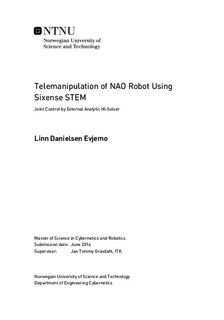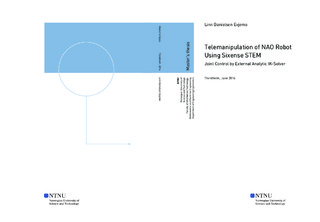| dc.description.abstract | If it was possible to train robots to do new tasks instead of programming them directly, robots would be able to perform a greater variety of tasks that are usually carried out manually, both in industry and in society in general. This could for example be achieved by demonstrating the motion or task repeatedly through robot telemanipulation. In such a system, minimal latency is crucial in order for the robot control to feel natural. The focus of this project has been to find an effective way of performing telemanipulation of the arms of a NAO robot from Aldebaran Robotics using the motion-tracker system Sixense STEM. The motivation was to make the robot follow the movements of a hand-held motion tracker in as close to real-time as possible.
This Master thesis is a continuation of the work done in a summer project during the summer of 2015, and a project thesis written in the fall of 2015. This project has attempted using joint control methods to control the robot, as previous work has shown that Cartesian control methods for the NAO robot are very slow. An analytic inverse kinematics (IK) solver for the NAO robot developed by Nikolaos Kofinas at the University of Crete has been tested to transform the STEM-tracker's trajectory to the necessary joint angles. In the end it was unfortunately not possible to create a functioning system. An analytic IK-solver will only return solutions for feasible combinations of position and orientation. Because the robot's arm has fewer degrees of freedom than a human arm, it is impossible for the robot arm to follow the exact motions of a human arm. This meant that most of the tracker data sent to the IK-solver from the hand-held STEM-tracker was infeasible, and hence the IK-solver was not able to return valid solutions.
Some of the focus in this project has also been on determining whether or not the Sixense STEM system is suitable for this kind of work. The system used in this project is a BETA-version, and the commercial version of the system has not been released yet. When the system is fully developed, it will probably be a good choice of hardware, as it is very accurate when it works as it should. However, the system currently has many bugs and problems that are both limiting and time-consuming. The conclusion is therefore that the STEM-system is not suitable for this kind of project work at this stage. | |

